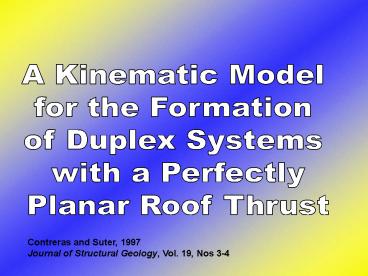A Kinematic Model PowerPoint PPT Presentation
1 / 11
Title: A Kinematic Model
1
A Kinematic Model for the Formation of Duplex
Systems with a Perfectly Planar Roof Thrust
Contreras and Suter, 1997 Journal of Structural
Geology, Vol. 19, Nos 3-4
2
How you get this
(and not this)
3
Assumptions and parameters of the model AND how
it differs from those previous
Assumptions 1) All ramps have constant dip 2)
All ramps are regularly spaced 3) Deformation in
direction of tectonic transport
- Parameters
- Applies to shortening or extension regions (not
strike-slip) - 2D (cross-section) geometry only
- Constant displacement trajectory
- Dude, theyre totally messing with the kink
method - Also, this leads to changing thickness of
forelimb
- Differences from previous models
- Bed thicknesses/lengths change
- Parallel axial planes
4
Into the nitty gritty
- The authors define two main variables that will
determine - the necessary length ratios between the
separation (s), - displacement (u), and length of the ramps (l)
- Number of horses
- Whether displacement is large or small (whether
displacement is - greater than or less than the ramp length
5
Consequently leading to this mess
6
The authors get this graph by (somewhat
painfully) going step-by-step (day by day)
through four examples 2 horses with large
displacement 2 horses with small
displacement 3 horses with large
displacement 3 horses with small
displacement THE PAYOFF They then derive 2
general formulas, one that will work for n
horses with large displacement, and one for n
horses with small displacement. Ill spare you
guys the gory details, but will go through ONE
example so you get a general idea of whats
going on.
http//www.alanandsandycarey.com/Domestic/Horses/p
ages/Quarter20Horse20crossing20Stream.htm
7
Example 2 horses, Large displacement (ugtl)
The associated geometry/algebra To get a planar
roof thrust, we need III to move where I is.
This will happen when displacement of the second
horse (u2) is as follows U2 s-(u1 lr)
l Toss in a few trig identities and you get that
lrl So u2s-u1-ll ? u2s-u1 u1 u2 s
OR u/s ½ (b/c u1u2)
Trig identities used Sina 2sin(a/2)cos(a/2) Cos
a cos2 (a/2) sin2(a/2)
In this SPECIFIC case, the sum of the
displacements along the two ramps equals their
separation
8
(No Transcript)
9
After going through this exercise for the other
cases listed previously, the authors generalize
the equations and kindly define the co-domains of
each
u/s (n-1)/n for 1/n l/s gt 0 D(n) u/s l/s
1 for (n1)/n gt u/s gt (n-2)/(n-1)
u/s ½ for (n-1)/2 l/s gt (n-2)/2 d(n) u/s
l/s(n-l) 1 for ½ gtu/s gt0
10
u/s (n-1)/n for 1/n l/s gt 0 D(n) u/s l/s
1 for (n1)/n gt u/s gt (n-2)/(n-1)
Lets look at n2 and n3 and we see
that it TOTALL FITS!!
11
Questions????

